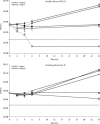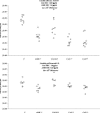Effects of caspofungin against Candida guilliermondii and Candida parapsilosis
- PMID: 16870764
- PMCID: PMC1538640
- DOI: 10.1128/AAC.00111-06
Effects of caspofungin against Candida guilliermondii and Candida parapsilosis
Abstract
The in vitro activity of caspofungin (CAS) was investigated against 28 yeast isolates belonging to Candida albicans (n = 5), Candida guilliermondii (n = 10), and Candida parapsilosis (n = 13). CAS MICs obtained by broth dilution and Etest methods clearly showed a rank order of susceptibility to the echinocandin compound with C. albicans > C. parapsilosis > C. guilliermondii. Similarly, time-kill assays performed on selected isolates showed that CAS was fungistatic against C. albicans and C. parapsilosis, while it did not exert any activity against C. guilliermondii. In a murine model of systemic candidiasis, CAS given at doses as low as 1 mg/kg of body weight/day was effective at reducing the kidney burden of mice infected with either C. albicans or C. guilliermondii isolates. Depending on the isolate tested, mice infected with C. parapsilosis responded to CAS given at 1 and/or 5 mg/kg/day. However, the overall CFU reduction for C. guilliermondii and C. parapsilosis was approximately 100-fold less than that for C. albicans. Our study shows that CAS was active in experimental systemic candidiasis due to C. guilliermondii and C. parapsilosis, but this activity required relatively high drug dosages.
Figures








References
-
- Abruzzo, G. K., A. M. Flattery, C. J. Gill, L. Kong, J. G. Smith, V. B. Pikounis, J. M. Balkovec, A. F. Bouffard, J. F. Dropinski, H. Rosen, H. Kropp, and K. Bartizal. 1997. Evaluation of the echinocandin antifungal MK-0991 (L-743,872): efficacies in mouse models of disseminated aspergillosis, candidiasis, and cryptococcosis. Antimicrob. Agents Chemother. 41:2333-2338. - PMC - PubMed
-
- Barchiesi, F., A. M. Schimizzi, A. W. Fothergill, G. Scalise, and M. G. Rinaldi. 1999. In vitro activity of the new echinocandin antifungal, MK-0991, against common and uncommon clinical isolates of Candida species. Eur. J. Clin. Microbiol. Infect. Dis. 18:302-304. - PubMed
-
- Bartizal, K., C. J. Gill, G. K. Abruzzo, A. M. Flattery, L. Kong, P. M. Scott, J. G. Smith, C. E. Leighton, A. Bouffard, J. F. Dropinski, and J. Balkovec. 1997. In vitro preclinical evaluation studies with the echinocandin antifungal MK-0991 (L-743,872). Antimicrob. Agents Chemother. 41:2326-2332. - PMC - PubMed
-
- Denning, D. W. 2003. Echinocandin antifungal drugs. Lancet 362:1142-1151. - PubMed
-
- Di Bonaventura, G., I. Spedicato, C. Picciani, D. D'Antonio, and R. Piccolomini. 2004. In vitro pharmacodynamic characteristics of amphotericin B, caspofungin, fluconazole, and voriconazole against bloodstream isolates of infrequent Candida species from patients with hematologic malignancies. Antimicrob. Agents Chemother. 48:4453-4456. - PMC - PubMed
Publication types
MeSH terms
Substances
LinkOut - more resources
Full Text Sources
Other Literature Sources

